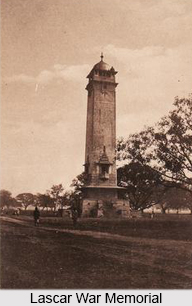 Lascar War Memorial is located on the Napier Road in the Hastings area of Kolkata. This war memorial is dedicated to the soldiers of Bengal, who laid their lives during the First World War, now maintained by Indian Navy.
Lascar War Memorial is located on the Napier Road in the Hastings area of Kolkata. This war memorial is dedicated to the soldiers of Bengal, who laid their lives during the First World War, now maintained by Indian Navy.
Location of Lascar War Memorial
Lascar War Memorial is situated at the southern end of the Maidan, on Naiper Road, Hastings, near Prinsep Ghat. The 100 feet high monument was unveiled by Lord Lytton, then Governor of Bengal on 6th February 1924.
History of Lascar War Memorial
According to the history of modern India, there was a sailor or militiaman from India or other countries east of the Cape of Good Hope, employed on European ships from the 16th century until the beginning of the 20th century. The word comes from the Persian "Lashkar", meaning military camp or army, and al-askar, the Arabic word for a guard or soldier. The Portuguese adapted this term to lascarim, meaning an Asian militiaman or seaman, especially those from the Indian Subcontinent. The lascars served on British ships under `lascar` agreements which gave ship-owners more control than the usual agreement. The sailors could be transferred from one ship to another and retained in service for up to three years at one time. The name "lascar" was also used to refer to Indian servants, typically engaged by British military officers.
Architecture of Lascar War Memorial
Lascar War Memorial was erected by shipping and mercantile companies, in the memory of the 896 Lascars of undivided Bengal and Assam who lost their lives during World War I.
Dedication of Lascar War Memorial
Lascar War Memorial is a memorial dedicated to the memory of 896 Lascars (sailor or militiaman from Indian subcontinent), who died fighting for the British Navy during the Great War of 1914 - 18 (World War I).
Architectural Style of Lascar War Memorial
Lascar War Memorial was built in typical Oriental style. It is a four-sided column, having designs reflecting the prow of an ancient galley on each side of the column. The upper part of the monument consists of four small minarets and a large gilt dome. A typical Indian look has been given by adding wavy lines beneath the projected balcony, which symbolises waves, along with chhajjas and trellises.
Similarity of Lascar War Memorial
Lascar War Memorial has similarities with the victory tower of Chittor. The memorial built in the Indo-Mughal style by William Ingram Keir, who also designed the Kidderpore Bridge, buildings at Bengal Engineering and Science University in Shibpur, the Indian Institute of Technology, Kharagpur, and Islamia College, and also replaced the 1934 earthquake affected spire of St. Paul`s Cathedral, Kolkata with a tower. William Ingram Keir won a prize of rupees 500 for designing the memorial.
Inside Lascar War Memorial
The inside of Lascar War Memorial is approached through a huge doorway on the Northern wall. The interior contains three plaques below the inscription Lascar Memorial.
Plaque of Lascar War Memorial
There is one plaque that commemorates the unveiling of the memorial by Lord Lytton, then Governor of Bengal on 6th Feb. 1924. The second plaques says that the memorial was erected by shipping and mercantile community of India in memory of the 896 seamen of Bengal Assam and upper India who lost their lives in service of the British Empire in India in the great war of 1914 - 1918. The third smaller plaques tell about the renovation and lighting of the Lascar War Memorial.
Related Articles
Capital Cities of India
History of Kolkata
Kolkata, Indian City, West Bengal
Culture of Kolkata
Economy of Kolkata
West Bengal, Indian State
Monuments in Kolkata, West Bengal Monuments
History of Bengali Theatre
Birla Planetarium, Kolkata
Siraj-Ud-Daulah, Nawab of Bengal
Battle of Plassey
Mir Jafar, Nawab of Bengal
Minhaj al-Siraj Juzjani
British Empire in India
Impact of British Rule in India
British Military Architecture in India
British East India Company
Indian English literature During British India
Robert Clive, Founder of British Empire in India
Dual Government of Bengal, Modern History of India
Battle of Buxar
Anglo-Mysore Wars
Significance of Battle of Plassey
Battle of Laswari, Maratha Empire
Battle of Rajmahal, Indian History
Indian War Memorial Museum, New Delhi
Monuments in Chennai
Victory War Memorial, Chennai
French War Memorial, Puducherry
Historical Monuments Of Pune
Monuments of Delhi



















